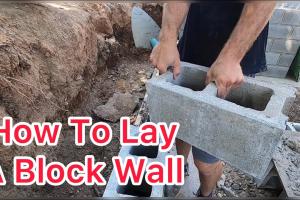Mastering Block Wall Construction: Your Complete Guide to Laying Cement and Cinder Blocks

-
Quick Links:
- Introduction
- Materials and Tools Needed
- Planning Your Block Wall
- Foundation Preparation
- Laying the Blocks
- Finishing Touches
- Case Studies and Examples
- Expert Insights
- FAQs
Introduction
Laying a block wall using cement or cinder blocks is a rewarding project that enhances the aesthetics and functionality of your outdoor or indoor space. Whether you’re building a garden wall, a privacy barrier, or a structural wall for your home, understanding the process is crucial for a successful build. This comprehensive guide will walk you through every step of the way, ensuring you have the knowledge and confidence to lay your block wall effectively.
Materials and Tools Needed
Essential Materials
- Cement blocks (standard or cinder)
- Cement mix
- Mortar mix
- Water
- Reinforcement materials (rebar, wire mesh)
Tools Required
- Trowel
- Level
- Measuring tape
- Brick hammer
- Mixing bucket or wheelbarrow
- Safety gear (gloves, goggles)
Planning Your Block Wall
Before diving into construction, meticulous planning is essential. Consider the following steps:
- Design: Determine the purpose of your wall and create a design that meets your needs.
- Location: Choose a suitable location, ensuring it complies with local building codes.
- Dimensions: Measure the area accurately to calculate how many blocks you will need.
Foundation Preparation
Foundation is key to a sturdy block wall. Here’s how to prepare:
- Excavation: Dig a trench that matches the width of your blocks and is deep enough for a solid foundation.
- Base Layer: Pour a base layer of concrete to set the blocks on, ensuring it's level.
Laying the Blocks
Step-by-Step Guide
- Mix the Mortar: Follow the manufacturer's instructions for mixing mortar. Aim for a consistency that’s workable but not too dry.
- Start at the Corners: Begin laying blocks at the corners of your wall, establishing a straight line.
- Check for Level: Use a level frequently to ensure each block is even.
- Stagger the Joints: Alternate block placement in each row to enhance stability.
- Fill Joints: Use mortar to fill the joints between blocks as you go.
Finishing Touches
Once the blocks are laid, it's time for finishing touches:
- Cleaning: Clean any excess mortar from the blocks before it hardens.
- Sealing: Consider applying a sealant for added durability.
Case Studies and Examples
Real-world examples can inspire and inform your project. Here are a few case studies:
- Backyard Privacy Wall: A homeowner built a cinder block wall for privacy, focusing on aesthetic design with a stucco finish.
- Garden Retaining Wall: A local community garden project utilized cinder blocks to create functional planting beds.
Expert Insights
We consulted with masonry experts to gather tips for successful block wall construction:
- Always check local regulations before starting your project.
- Use high-quality materials for durability.
FAQs
1. What is the difference between cement blocks and cinder blocks?
Cement blocks are denser and often stronger than cinder blocks, which are lighter and contain ash.
2. How deep should the foundation be for a block wall?
The foundation should be at least 6 inches deep but can vary based on local soil conditions.
3. Can I build a block wall without professional help?
Yes, with proper guidance and planning, many DIYers successfully lay block walls themselves.
4. How long does it take to cure the mortar?
Mortar typically takes 24 to 48 hours to cure adequately, but full strength may take weeks.
5. Do I need a permit to build a block wall?
Most municipalities require permits for structural walls; always check local regulations.
6. What tools are essential for laying a block wall?
Key tools include a trowel, level, measuring tape, and mixing bucket.
7. Can I paint my block wall?
Yes, painting is possible, but it’s recommended to use masonry-specific paint for best results.
8. Is drainage necessary for my block wall?
Yes, proper drainage can help prevent water accumulation and damage.
9. How can I enhance the aesthetics of my block wall?
Consider adding a stucco finish, painting, or incorporating landscaping elements.
10. What are some common mistakes to avoid?
Avoid rushing the process, neglecting foundation preparation, and failing to level the blocks.
Conclusion
Building a block wall with cement or cinder blocks can seem daunting, but with the right materials, tools, and techniques, you can achieve a durable and attractive structure. This guide has provided you with everything you need to know to get started, from planning and preparation to finishing touches. Embrace the project, and enjoy the satisfaction of creating something solid and lasting!
For more information and resources on construction techniques, visit the following authoritative sources:
- Houzz - How to Build a Retaining Wall
- NAHB - How to Build a Wall
- Verywell Family - How to Build a Backyard Fire Pit
Random Reads
- How to lock ipad screen orientation
- How to winterize a vacant home
- How to wire 4 way switch
- How to identify asbestos mastic
- How to hook up a pool vacuum
- Mastering the art of selling
- How to recover hacked roblox account
- How to install ssd in laptop
- How to install ssl certificate
- How to see if someone read your text on samsung galaxy